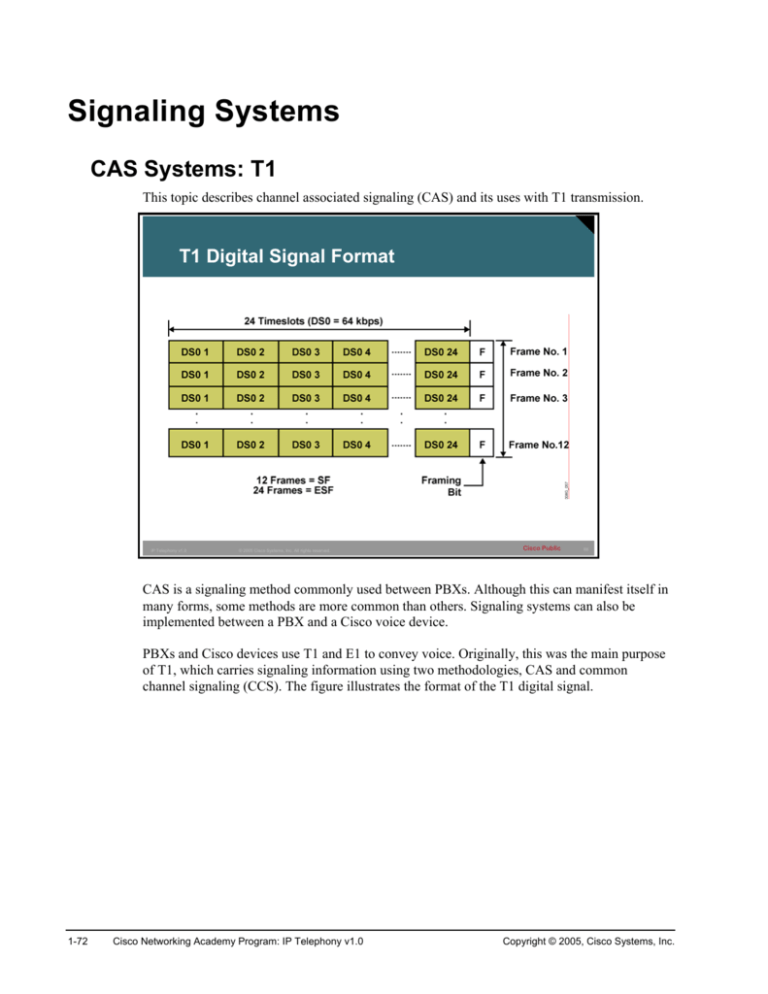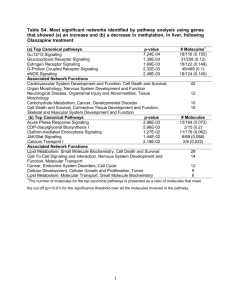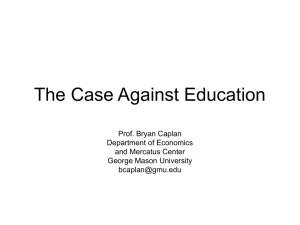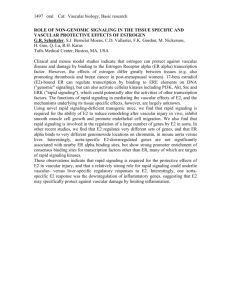
Signaling Systems
CAS Systems: T1
This topic describes channel associated signaling (CAS) and its uses with T1 transmission.
T1 Digital Signal Format
IP Telephony v1.0
© 2005 Cisco Systems, Inc. All rights reserved.
Cisco Public
66
CAS is a signaling method commonly used between PBXs. Although this can manifest itself in
many forms, some methods are more common than others. Signaling systems can also be
implemented between a PBX and a Cisco voice device.
PBXs and Cisco devices use T1 and E1 to convey voice. Originally, this was the main purpose
of T1, which carries signaling information using two methodologies, CAS and common
channel signaling (CCS). The figure illustrates the format of the T1 digital signal.
1-72
Cisco Networking Academy Program: IP Telephony v1.0
Copyright © 2005, Cisco Systems, Inc.
The characteristics of the T1 digital signal format are as follows:
A T1 frame is 193 bits long—8 bits from each of the 24 timeslots (digital service zeros
[DS0s]) plus 1 bit for framing. A T1 repeats every 125 microseconds, resulting in 8000
samples per second (8 bits * 24 timeslots + 1 framing bit * 8000 samples/second =
1.544 Mbps).
T1 has two major framing and/or format standards:
—
Super Frame (SF), or D4, specifies 12 frames in sequence. The D4 framing pattern
used in the F position in the figure is 100011011100 (a 1 goes with the first frame, a
0 goes with the second frame, a 0 goes with the third frame, and so on all the way
through 12 frames). This unique framing pattern allows the receiving T1 equipment
to synchronize within four frames, since any four consecutive frame bits are unique
within the 12-bit pattern. Because there are 8000 T1 frames transmitted per second,
8000 F bits are produced and used for framing.
—
Extended Superframe (ESF) format was developed as an upgrade to SF and is now
dominant in public and private networks. Both types of format retain the basic frame
structure of one framing bit followed by 192 data bits. However, ESF repurposes the
use of the F bit. In ESF, of the total 8000 F bits used in T1, 2000 are used for
framing, 2000 are used for cyclic redundancy check (CRC) (for error checking
only), and 4000 are used as an intelligent supervisory channel to control functions
end to end (such as loopback and error reporting).
Copyright © 2005, Cisco Systems, Inc
Introduction to Packet Voice Technologies > Signaling Systems
1-73
Robbed-Bit Signaling
IP Telephony v1.0
© 2005 Cisco Systems, Inc. All rights reserved.
Cisco Public
67
Because each DS0 channel carries 64 kbps, and G.711 is 64 kbps, there is no room to carry
signaling. Implemented for voice, the T1 uses every sixth frame to convey signaling
information. In every sixth frame, the least significant bit (LSB) for each of the voice channels
is used to convey the signaling. Although this implementation detracts from the overall voice
quality (because only seven bits represent a sample for that frame), the impact is not significant.
This method is called robbed-bit signaling (RBS). When SF employs this method, the signaling
bits are conveyed in both the 6th (called the “A” bit) and 12th (called the “B” bit) frames. For
control signaling, A and B bits provide both near- and far-end off-hook indication.
The A and B bits can represent different signaling states or control features (on hook or off
hook, idle, busy, ringing, and addressing). The robbed bit is the least significant bit from an
8-bit word.
ESF also uses RBS in frames 6, 12, 18, and 24, which yields ABCD signaling options,
providing additional control and signaling information.
1-74
Cisco Networking Academy Program: IP Telephony v1.0
Copyright © 2005, Cisco Systems, Inc.
Channel Associated Signaling—T1
IP Telephony v1.0
Cisco Public
© 2005 Cisco Systems, Inc. All rights reserved.
68
Because the signaling occurs within each DS0, it is referred to as in band. Also, because the use
of these bits is exclusively reserved for signaling each respective voice channel, it is referred to
as CAS.
The robbed bits are used to convey E&M status or FXS/FXO status and provide call
supervision for both on hook and off hook.
Example: Channel Associated Signaling
D4 has a 12-frame structure and provides AB bits for signaling.
ESF has a 24-frame structure and provides ABCD bits for signaling.
DTMF, or tone, can be carried in band in the audio path; however, other supervisory signals
must still be carried via CAS.
Copyright © 2005, Cisco Systems, Inc
Introduction to Packet Voice Technologies > Signaling Systems
1-75
CAS Systems: E1
This topic describes CAS and its uses with E1 transmission.
E1 Framing and Signaling
IP Telephony v1.0
© 2005 Cisco Systems, Inc. All rights reserved.
Cisco Public
69
In E1 framing and signaling, 30 of the 32 available channels, or timeslots, are used for voice
and data. Framing information uses timeslot 1, while timeslot 17 (E0 16) is used for signaling
by all the other timeslots. This signaling format is also known as CAS because the use of the
bits in the 17th timeslot is exclusively reserved for the purpose of signaling each respective
channel. However, this implementation of CAS is considered out of band because the signaling
bits are not carried within the context of each respective voice channel, as is the case with T1.
1-76
Cisco Networking Academy Program: IP Telephony v1.0
Copyright © 2005, Cisco Systems, Inc.
Channel Associated Signaling—E1
Cisco Public
© 2005 Cisco Systems, Inc. All rights reserved.
IP Telephony v1.0
70
In the E1 frame format, 32 timeslots make up a frame. A multiframe consists of 16 E1 frames,
as depicted in the figure.
The timeslots are numbered 1 though 32. Multiframe timeslots are configured as follows:
Timeslot 1 carries only framing information.
Timeslot 17, in the first frame of the 16-frame multiframe, declares the beginning of the
multiframe, which is indicated by the M symbol in the figure.
The remaining slot 17s carry signaling information for all the other timeslots:
—
Slot 17 of the first frame declares the beginning of a 16-frame multiframe (M).
—
Slot 17 of the second frame carries ABCD for voice slot 2 (X) and ABCD for voice
slot 18 (Y).
—
Slot 17 of the third frame carries ABCD for voice slot 3 (X) and ABCD for voice
slot 19 (Y).
—
This process continues for all of the remaining frames.
Example: E1 Channel Associated Signaling
E1 CAS is directly compatible with T1 CAS, because both methods use AB or ABCD bit
signaling. Although the signaling for E1 CAS is carried in a single common timeslot, it is still
referred to as CAS because each individual signaling timeslot represents a specific pair of
voice channels.
Copyright © 2005, Cisco Systems, Inc
Introduction to Packet Voice Technologies > Signaling Systems
1-77
CCS Systems
This topic describes common channel signaling (CCS) systems.
Common Channel Signaling
IP Telephony v1.0
© 2005 Cisco Systems, Inc. All rights reserved.
Cisco Public
71
CCS differs from CAS in that all channels use a common channel and protocol for call setup.
Using E1 as an example, a signaling protocol, such as the ISDN Q.931, would be deployed in
timeslot 17 to exchange call-setup messages with its attached telephony equipment.
Example: CCS Signaling
Examples of CCS signaling are as follows:
1-78
Proprietary implementations: Some PBX vendors choose to use CCS for T1 and E1 and
implement a proprietary CCS protocol between their PBXs. In this implementation, Cisco
devices are configured for Transparent Common Channel Signaling (T-CCS) because they
do not understand proprietary signaling information.
ISDN: Uses Q.931 in a common channel to signal all other channels.
Digital Private Network Signaling System (DPNSS): An open standard developed by
British Telecom for implementation by any vendor who chooses to use it. DPNSS also uses
a common channel to signal all other channels.
Q Signaling (QSIG): Like ISDN, uses a common channel to signal all other channels.
Signaling System 7 (SS7): An out-of-band network implemented and maintained by
various telephone companies and used for signaling and other supplemental services.
Cisco Networking Academy Program: IP Telephony v1.0
Copyright © 2005, Cisco Systems, Inc.
ISDN
This topic describes how to implement ISDN as a signaling system to support voice.
ISDN
• ISDN
Part of network architecture
Definition for access to the network
Allows access to multiple services through
a single access
Used for data, voice, or video
• Standards-based
ITU recommendations
Proprietary implementations
Cisco Public
© 2005 Cisco Systems, Inc. All rights reserved.
IP Telephony v1.0
72
ISDN is an access specification to a network. You may have studied ISDN as an access method
for dialup data systems. Because it is a digital system, ISDN makes connections rapidly.
ISDN can be implemented in two different ways: BRI and PRI. BRI features two bearer (B)
channels, while PRI supports 23 (for T1) or 30 (for E1) B channels. Each implementation also
supports a data (D) channel, used to carry signaling information (CCS).
The following are benefits of using ISDN to convey voice:
Each B channel is 64 kbps, making it perfect for G.711 PCM.
ISDN has a built-in call control protocol known as ITU-T Q.931.
ISDN can convey standards-based voice features, such as call forwarding.
ISDN supports standards-based enhanced dialup capabilities, such as Group 4 fax and
audio channels.
Note
ISDN BRI voice is commonly used in Europe; ISDN PRI voice is used worldwide.
Copyright © 2005, Cisco Systems, Inc
Introduction to Packet Voice Technologies > Signaling Systems
1-79
ISDN Network Architecture
IP Telephony v1.0
© 2005 Cisco Systems, Inc. All rights reserved.
Cisco Public
72
The figure here depicts the architecture of an ISDN network. The B channel carries
information, such as voice, data, and video, at 64-kbps DS0.
The D channel carries call signaling between customer premises equipment (CPE) and the
network, usually as the Q.931 protocol but sometimes as the QSIG protocol.
BRI operates using the average local copper pair. It uses two B channels and one signaling
channel. It is represented as 2 B+D.
PRI implemented on T1 uses 23 B channels and one signaling channel. It is represented as 23
B+D. PRI implemented on E1 uses 30 B channels and one signaling channel. It is represented
as 30 B+D.
1-80
Cisco Networking Academy Program: IP Telephony v1.0
Copyright © 2005, Cisco Systems, Inc.
Layer 3 (Q.930/931) Messages
IP Telephony v1.0
© 2005 Cisco Systems, Inc. All rights reserved.
Cisco Public
73
Layer 3, Q.931, uses a standard set of messages to communicate. These standard commands
cover the following areas:
Call establishment: Initially sets up a call. Messages travel between the user and the
network. Call establishment events include alerting, call proceeding, connect, connect
acknowledgment, progress, setup, and setup acknowledgment.
Call information phase: Data sent between the user and the network after the call is
established. This allows the user to, for example, suspend and then resume a call. Events in
the call information phase include: hold, hold acknowledgment, hold reject, resume,
resume acknowledgment, resume reject, retrieve, retrieve acknowledgment, retrieve reject,
suspend, suspend acknowledgment, suspend reject, and user information.
Call clearing: Terminates a call. The following events occur in the call-clearing phase:
disconnect, release, release complete, restart, and restart acknowledgment.
Miscellaneous messages: Negotiates network features (supplementary services).
Miscellaneous services include congestion control, facility, information, notify, register,
status, and status inquiry.
Example: ISDN Messages
ISDN Layer 3 messages, or Q.931, are carried within ISDN Layer 2 frames, called Q.921.
Cisco ISDN equipment allows the administrator to monitor these messages as they occur using
various debug commands.
Copyright © 2005, Cisco Systems, Inc
Introduction to Packet Voice Technologies > Signaling Systems
1-81










